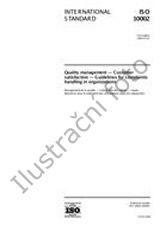Potřebujeme váš souhlas k využití jednotlivých dat, aby se vám mimo jiné mohly ukazovat informace týkající se vašich zájmů. Souhlas udělíte kliknutím na tlačítko „OK“.

ISO/TR 12391-4:2002
Gas cylinders — Refillable seamless steel — Performance tests — Part 4: Flawed-cylinder cycle test
Automaticky přeložený název:
Plynové lahve - Doplňovací bezešvé ocelové - Výkonnostní zkoušky - Část 4: Zkušební Flawed válec cyklus
NORMA vydána dne 11.12.2002
Informace o normě:
Označení normy: ISO/TR 12391-4:2002
Datum vydání normy: 11.12.2002
Kód zboží: NS-420571
Počet stran: 22
Přibližná hmotnost: 66 g (0.15 liber)
Země: Mezinárodní technická norma
Kategorie: Technické normy ISO
Kategorie - podobné normy:
Anotace textu normy ISO/TR 12391-4:2002 :
Description / Abstract: This part of ISO/TR 12391 applies to seamless steel refillable cylinders of all sizes from 0,5 l up to and including 150 l water capacity produced of steel with tensile strength, Rm, greater than 1 100 MPa. It can also be applied to cylinders produced from steels used at lower tensile strengths. In particular, it provides the technical rationale and background to guide future alterations of existing ISO standards or for developing advanced design standards. This part of ISO/TR 12391 is a summary and compilation of the test results obtained during the development of the "flawed-cylinder cycle test". The "flawed-cylinder cycle test" was developed as part of a co-operative project under the direction of ISO/TC 58/SC 3/WG 14. The "flawed-cylinder cycle test" is a test method to evaluate the fatigue performance of steel cylinders that are used to transport high pressure, compressed gases. The concept and development of the flawed-cylinder cycle test is described in ISO/TR 12391-1. The details of the test method and the criteria for acceptable fatigue performance of steel cylinders are given in 9.2.6 of ISO 9809-2:2000, "flawed-cylinder cycle test". In this part of ISO/TR 12391, test results are reported for more than a hundred flawed-cylinder cycle tests that were conducted on seamless steel cylinders ranging in measured tensile strength from less than 800 MPa to greater than 1 350 MPa. The test method is intended to be used for the selection of materials and design parameters in the development of new cylinder designs.



 Cookies
Cookies
